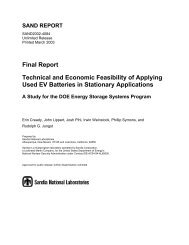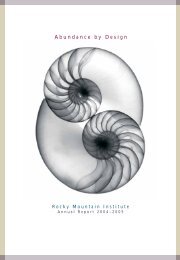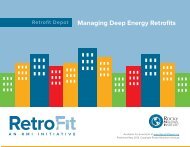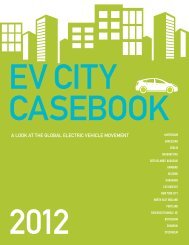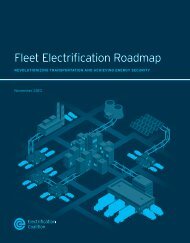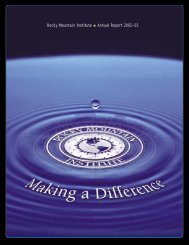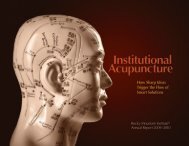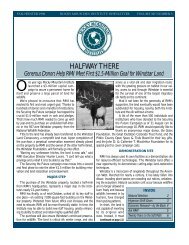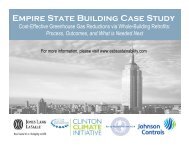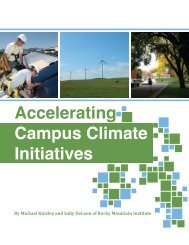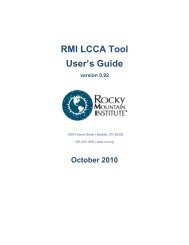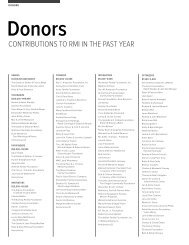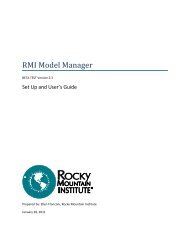Whole-Systems Thinking - Rocky Mountain Institute
Whole-Systems Thinking - Rocky Mountain Institute
Whole-Systems Thinking - Rocky Mountain Institute
You also want an ePaper? Increase the reach of your titles
YUMPU automatically turns print PDFs into web optimized ePapers that Google loves.
<strong>Whole</strong>-<strong>Systems</strong> <strong>Thinking</strong><strong>Rocky</strong> <strong>Mountain</strong> <strong>Institute</strong>Annual Report2000—2001
RMI: Where We Came FromThe situation prompted a 29-year-old Oxford Universitydropout (who was also theyoungest don in the university’shistory) to pose his ownideas about the world’s energysituation. In “Energy Strategy:The Road Not Taken?,” publishedin the Fall 1976 issueof Foreign Affairs, physicistAmory Bloch Lovins stoodthe policy world on its headby asking and answering avery different set of questions.Rather than focusing on howto get more energy, he asked,“What are the tasks for whichwe need energy? How muchA portrait of the artist as a young man: RMI’s Amory Lovins as he appeared in TheMother Earth News, November/December 1977.and what kinds of energy dowe need for each task? Andwhat is the cheapest way to supplythat energy?”This “end-use/least-cost” idea turnedenergy thinking around and stillunderpins much of RMI’s work.Meanwhile, the Foreign Affairs articlehad an explosive effect. The Senateheld hearings on the concept. The conventionalenergy industry attackedAmory. For two years he wrote heavilydocumented responses to dozens ofattacks on him. Congress published theresults in two fat volumes that came tobe known as “The Green Paperweight.”In 1979, the environmental organizationFriends of the Earth published thecriticisms and rebuttals, edited downto one volume called The EnergyControversy.Amory’s approach might seem likecommon sense, but in the mid-1970s,the general thinking about energy wasbackwards: first produce the energy,then sell it. But by focusing first on thejob to be done, then matching supplyin scale and quantity to that end-use,and suggesting that the cheapest wayto meet our needs is to deliver theenergy services more efficiently, Amoryrevolutionized energy policy.The ‘Human’ Side of<strong>Whole</strong>-<strong>Systems</strong> <strong>Thinking</strong>In the early 1970s, Hunter Sheldon wasa feisty young law student in SouthernCalifornia. She was a barrel-racing cowgirl,“People have never actually wanted kilowatt-hours ofelectricity or barrels of oil. Rather, they want the ‘enduseservices’ that energy provides—hot showers, coldbeer, baked bread, smelted alumina, comfort, mobility,and so on. Thus, it’s the cost and manner of obtainingthose services—not of the energy that drives them—thatshould be the central focus of energy policy.”a firefighter, a forester, and aperson with a passion for effectivesolutions. She saw law school as a wayto learn the policy tools to createchange, not as a career path to a bigsalary. So rather than interning atsome fancy firm, she teamed with anactivist named Andy Lipkis to help—Amory Lovins, CEO (Research)him implement a project to plant treesin Los Angeles and the surroundingpage 4
RMI: Where We Came From“We’d show the VP of finance for some utility that was ina life-or-death struggle with anti-nuclear protesters that ifthe company completed the power plant it would losemoney. Then we’d say, ‘Your choice. You don’t have to beanti-nuclear, but it you favor the financial health of yourcompany, you’ll cancel that plant.’ Many did—andthanked us afterwards for having saved their company.”by building power plants. The Lovinsesmet with policymakers from WallStreet to Main Street, showing thatevery new plant that comes on linewould waste money that could bemore effectively spent on efficiency,and that cheaper, better alternativeswere entering the market, offeringbetter service at lower risk.A House Where?Life on the road can make anyonethink about settling down.As the Lovinses started to talk aboutwhere in the world they might like tolive someday, they realized that the—Hunter Lovins, CEO (Strategy)choice depended first on comparativejurisprudence. Much of their workthen was on nuclear non-proliferationissues. They had written technicalpapers and a book on how the plutoniumused in nuclear power plants canalso be used to produce very effectivenuclear weapons. It was a sensitivetopic worldwide, and every nation onearth, except to some degree theUnited States, could declare suchwriting a violation of official secretslaws. Because of the American constitutionand justice system, Hunter andAmory felt they ought to settle in theU.S.Hunter and Amory dreamed of a ruralretreat where they would have thetime and mental space to think andwrite. To be effective without theinfrastructure of a city, they neededgood air service, computer repair, amodern phone system, and the sortsof amenities that few small townsthen offered. After exploring offersfrom many parts of the country, theypicked the Aspen area, not onlybecause it offered the needed services,but also because it was a place manypeople want an excuse to come to—which, thought the Lovinses, wouldenable them to travel less. (It was agood theory—Amory still travels abouthalf the time, Hunter about a quarter.And tens of thousands of visitors havecome to them.)The Lovinses also suspected that thelessons they had learned from energypolicy would apply to water policy,which was making the same mistakesas energy: trying to supply more, atany cost, from any source, andignoring more efficient use. Mostwater is used in agriculture, which wasalso in a crisis. The collapse of agriculturaltowns was leading to economicdevelopment policies that were allsupply-oriented: attract new industry,rather than increase local self-reliance.The Lovinses were concerned that badresource policy was making the worldless safe, thus increasing the demandfor nuclear weapons. All these issuesand many more were interrelated.Traditional policies that seek answersone at a time were only creating newLeft: Glory Days: RMI’s team, circa1985.page 6
RMI headquarters under construction, summer 1982.problems. But there were only two ofthem, and only 36 hours in a day. Ifthey were going to be able to thinkabout the bigger whole–systems, theywere going to need help. That meantsome form of organization. Huntersuggested that they create their owninstitute. Amory’s reaction was “Ohhorrors, administrivia!” Hunterassured him that she would look afterthe day-to-day management; all hehad to do was keep creating new ideasand ensure quality control. Thus, inApril 1982, <strong>Rocky</strong> <strong>Mountain</strong> <strong>Institute</strong>was born. They figured that a dozenpeople ought to do the trick.square-foot building is passive-solar,superinsulated, and earth-sheltered. Ithas no heating system in the usualsense, but is kept comfortable even at–20° F by passive solar gain throughthe superwindows. Bananas and fishflourish in the greenhouse. Savings of99 percent in space- and waterheatingenergy and 90 percent inhousehold electricity repaid their costin 10 months. More importantly,RMI’s headquarters building hasshown homeowners what’s possible.Every year we receive thousands ofinquiries from people looking tofollow the example.Info, Info EverywhereAlmost immediately, RMI startedattracting donations. One of the firstgrants was to apply the lessons ofwhole-systems thinking to water. Inthe early 1980s, America was buildingcentralized, capital-intensive supplytechnologies to deal with perceivedshortages rather than examining howshortages might be averted throughefficient use and distributed supplytechnologies at a local level.RMI researchers did one of the firstsolid analyses of using water efficiencyto displace the need for more supply,Energy-Efficient Bananasat 7,100 FeetIn 1982, the Lovinses worked witharchitect Steve Conger to design ahome for RMI. It reflected theirideal—efficient, smart, and comfortable.Built over the course of a yearand a half with over 100 volunteersguided by professionals, the 4,000-“RMI now has six full-time and eight part-time staff—equivalentto about ten full-time—and we will stabilize at about a dozen fulltime.... The computer is coming! RMI has so far gotten along witha borrowed typewriter, paper-ledger accounting and one (latelytwo) hard-wired dedicated word processors—fast but dumbLaniers of 1976 vintage … Rick Heede just pledged $50 from hismeager salary toward a portable computer.”—RMI’s First Newsletter, Dec. 15, 1984<strong>Rocky</strong> <strong>Mountain</strong> <strong>Institute</strong> Annual Report 2000—2001 page 7
RMI: Where We Came From“The logo was designed by a talented neighbor, who happenedto be a graphic artist. We wanted something that hadthe respectability of an academic seal, but also the glisten ofa new idea. The designer pointed out that if yourotate some stars a little bit they start to twinkle.We were stuck on what color to make it. A linefrom Jimmy Ibbotson’s song aboutColorado,‘Rippling Waters,’ was runningthrough my head: ‘Blue spruce flaming on the gratein the evening takes the chill away fine.’ I thought, ‘That’s it.Blue Spruce! That’s Colorado!’ I grabbed a hank of spruceneedles and said ‘Here, this color.’ We took the spruce needlesdown to the printer and found that officially, the coloris 16 parts process blue, 1 part black, but to us RMI’s color isthe State Tree of Colorado: blue spruce.”as well as a study of the economics ofefficiency. As part of the study, RMIcreated the first catalogue of availabletechnologies for using water more efficiently,then worked with other groupsto take on such tasks. Today there aretrade and professional associationsfocused entirely on water efficiency.This approach—of putting information—Hunter Lovins, CEO (Strategy)on the available technologies out intothe public realm, then fostering othergroups to maintain the flow of information—becameanother hallmark ofRMI’s approach: share information,then watch good people do greatthings. Today, plumbers’ supply companiespublish all sorts of catalogueson water-efficient devices (like showerheadsand toilets), but in the earlyRMI’s original Economic Renewal Team: Irene Friedman, Beth Richmond,Michael Kinsley, and Hunter Lovins, in 1985.1980s, such simple information wasunavailable.Our work with water has also blossomedinto a key element of our work.Longtime RMI researchers RichardPinkham and Bob Wilkinson are currentlyworking on efforts to show thatas with electricity, wastewater treatmentworks better and cheaper insmaller, distributed systems, as well aswhole-systems synthesis of managingentire basins.RMI Takes Itto the StreetsIn early 1983, local officials fightingthe threat of massive oil-shale miningin Western Colorado asked for RMI’shelp. The dismal economics of the proposalprobably had more to do with itsdemise than RMI’s analyses, but out ofthis work grew a conversation. MichaelKinsley, a Pitkin County Commissioner(where RMI is located), and Hunterbegan asking what real economicdevelopment for small rural townsshould look like. Together they createdRMI’s Economic Renewal (ER) department,offering sustainable alternativesto conventional development that canbe used by community leaders andactivists virtually anywhere.Assembling hundreds of stories of whatcommunities have done, they developeda hands-on process to enable citizensto discover and create their ownsuccesses. The detailed and now successfulEconomic Renewal Guide (alsoavailable in Spanish and Latvian) hasbeen used by coal towns, timberdependentcommunities, and eveninner-city neighborhoods.page 8
Michael and his ER team are nowdeveloping an interactive Web tool toprovide community-specific evidence—in terms of jobs, income, and avoidedpollution—that sustainable developmentcan compete favorably with conventionaldevelopment. ER takeswhole-systems thinking and makes itapplicable to local decisionmaking.A Private Spin-OffAround 1984, a nonprofit entrepreneurnamed Richard Steckel questionedwhether nonprofits should have to begfor a living. He felt that nonprofitsshould create for-profit businessesbased on their research and work; thenthey could do their service in thepublic interest but make a living fromit. The idea of combining RMI’s workand free enterprise appealed to theLovinses. They discussed many businessmodels based on RMI’s intellectualcapital, but none seemed right.In 1985, Hunter and Amory were inNew York briefing financial analystsand the folks at Business Week.Everywhere they went, people weretalking about how the electric utilitieswere in trouble. Many were goingbankrupt because they couldn’t affordto pay for the big centralized plantsRMI had advised them not to buy. Theindustry was in disarray. As RMI wastrying to guide policymakers andutility executives out of the mess,Hunter realized she’d found the businessthey’d been looking for. RMIbegan putting together an informationservice for electric utilities, utilities’major customers, and regulators.Originally called COMPETITEK, it provideddispassionate dataon all aspects of electricefficiency—“negawatts.”COMPETITEK took off,soon growing to eightemployees. But to achieveits mission, it needed tobehave more like a realbusiness than it could asa department of RMI. Itneeded larger offices,undistracted staff, and abottom-line mentality,not RMI’s long horizonand charitable mission. In1992, after two years offiguring out how to do it,COMPETITEK became RMI’s(and one of the country’s)first formal for-profitspinoff as a whollyowned,independentlymanaged subsidiary. ESOURCE, as it wasAmory, on the road with a show-and-tell kit ofrenamed, Soon became gizmos illustrating a U.S. energy efficiencyone of the nation’s potential of hundreds of gigawatts, in the mid-1980s.fastest-growing businessesand the premierprovider worldwide of technical and RMI also used the intellectual andstrategic information on advanced physical space to move into newelectric efficiency and related energy areas—specifically, commercializing theservices.Hypercar SM concept it had been incubatingsince 1990–91. (In 1999, theThe spinoff worked well in many ways,spinoff of Hypercar, Inc. would offerespecially after RMI, in 1995, gave twofifthsof the equity to E SOURCE’Sthat same physical and mental space tocreate the Natural Capitalism Practice.)employees as an incentive for furthergrowth, which soon reached 69 percenta year. The firm’s sale in 1999 to Powerful, WorldwideInfluencethe Financial Times group providedRMI with its first real start at anRMI's influence on the world duringendowment fund. Freed from the the past two decades has been nothingresponsibility of guiding its subsidiary, short of remarkable. Hundreds of indi-<strong>Rocky</strong> <strong>Mountain</strong> <strong>Institute</strong> Annual Report 2000—2001 page 9
RMI: Where We Came Fromviduals have passed through RMI'sstaff, en route to influential careers infields ranging from science and technologyto the arts and humanities.Some came to RMI already establishedas leaders in their fields; others workedat RMI and went on to great thingsafter RMI. Either way, many RMIteshave gone on to do significant work—just ask former General Secretary of theCommunist Party of the Soviet Union,Mikhail Gorbachev.In the late 1970s, a young Aspen kidnamed Hal Harvey went off toStanford, where he became involved inStanford’s Arms Control andDisarmament Program and securityissues. After Hal graduated, RMIbrought him on to run the <strong>Institute</strong>'ssecurity group. Hal, along with MikeShuman (now head of the <strong>Institute</strong> forHunter and Agent Orange (a pet iguana)examining an early 1990s banana crop inRMI’s headquarter’s “jungle.”Policy Studies) wrote a book on conflictmanagement (Security WithoutWar), describing what could be doneabout global security. In 1985, duringan RMI trip to the Soviet Union, Halwas able to meet with YevgenyVelikhov, a leading Soviet nuclearphysicist and one of the most influentialscientists in Russia. Hal, like a goodRMIte, shared the security ideas he andShuman were developing at RMI. Notlong thereafter, Gorbachev headed offto Reykjavik to announce unilateraldisarmament, and intensified his pathfor political openness (glasnost) andtransformation (perestroika). It’s difficultto know the extent of RMI'simpact on Soviet policymakers, but afew years after the event, RMI’s AmoryLovins was told by a member ofGorbachev’s cabinet that the Sovietleader had indeed been influenced byRMI’s fresh thinking on security.Hal Harvey now heads theEnergy Foundation.Other RMItes have led significantlives, with importantresults. Many have found theirway into government and privateindustry. Others havegone on to write influentialbooks or start organizations oftheir own. The Roaring ForkValley, RMI’s home, is filledwith RMItes who have becomecommunity leaders in development,sustainability, and environmentaland social issues.‘<strong>Whole</strong>-<strong>Systems</strong>’BuildingsBy the early 1990s, RMI’s OldHal Harvey in the mid-1980s.Snowmass neighbor, the WindstarFoundation, was shrinking. With morethan 30 staff and still growing, RMIworked out a deal in which it wouldmaintain Windstar’s Old Snowmassbuilding and grounds in exchange foruse of offices on the top floor.A young man named Bill Browning—one of the volunteers who’d help buildRMI’s headquarters—had worked atWindstar, but as the foundation contracted,he was laid off. RMI struck upa deal: RMI would support himthrough MIT real estate school on thecondition that he would return andestablish the green-buildings programthat Amory and Hunter had wanted tostart for years.In 1991, RMI established GreenDevelopment Services (GDS) to showthat a whole-systems approach todesign can make buildings more comfortable,more efficient, moreappealing, and ultimately more profitable.This approach gained rapid suc-page 10
Bill Browning in GDS’s early days.cess as RMI worked with developersinstead of against them. GDS staffguided the design for the “Greening ofthe White House,” the renovation ofthe Pentagon, the design for the athletes’village at the Sydney Olympics,and hundreds of other projects. GDSworks with developers, architects,facility managers, and other real-estateprofessionals to integrate resource-efficient,environmentally responsive, andculturally sensitive design into buildingsand communities. The results aremore profitable to build or retrofit, lesscostly to run, healthier and more comfortableto occupy, and more productiveto work in. This allowspractitioners to create and manage thebuilt environment in ways that dramaticallyimprove human and naturalcommunities. By now, with outreachsupport from the Urban Land <strong>Institute</strong>,the American <strong>Institute</strong> of Architects,and a large global network of practitioners,GDS is the acknowledgedleader in this revolutionary andrewarding approach to design anddevelopment.Today, as a result of GDS’s work, manypeople are enjoying more productive,happier, healthier working lives, andthe companies that employ them areseeing better bottom lines.Driving for SolutionsAround 1990, many people wereurging RMI to get involved in transportationissues. The request didn’tmake much sense to Amory andHunter. Other people were doingexcellent work in transportationpolicy—why us too? But Amoryaccepted a July 1991 invitation to cokeynotethe technology day of aNational Academy of Sciences symposiumon efficient vehicles. As a recoveringphysicist, he’d been curious for20 years about why, after a century ofengineering effort, cars were using onlyone percent of their fuel energy tomove the driver. And it occurred tohim that many, though not all, of thetransportation challenges could beresolved if someone created a bettercar, an uncompromised vehicle thatwas vastly more efficient and thatemitted nothing.In 1991, setting aside contemporaryautomotive design, Amory, Hunter anda collection of colleagues imaginedwhat a car could be if designed fromscratch. The result was the Hypercar SMvehicle—an ultralight, ultra-low-drag,hybrid-electric car with highly integrated,radically simplified, and software-richdesign. The resulting workwon the 1993 Nissan Prize andlaunched a new focus at RMI: an engineeringand policy group, the HypercarCenter®, which refined the concept indepth through 1998, one-third supportedby consulting and technicalpublications. The challenge becameRMI introduced the Hypercar SM concept in 1992. In the spring 2001,Hypercar inc., unveiled its prototype ‘Revolution.’ Photo: Norm Clasen<strong>Rocky</strong> <strong>Mountain</strong> <strong>Institute</strong> Annual Report 2000—2001page 11
RMI: Where We Came FromA young Rick Heede celebrating a birthday inRMI’s early years.getting the vehicle to market.“Taking natural capitalism to aworld scale means making it accessiblenot just to industry, but allsegments of society. Doing this willrequire far more people and workthan RMI alone can deliver. Ratherthan grow RMI to an unwieldysize, RMI will intensify and focusits collaboration with other organizationsto get the message out.”page 12etal loss.) The last thingwe wanted to see wasHypercar SM principlessimilarly stymied. Howcould we best ensurethat this design becametransformative, that itinvited or even forcedthe car companies to dosomethingcompletelydifferent?We decidedthe bestway wasthe freesoftwareapproach—putthe concepts in the publicdomain so nobody couldpatent them, then get everyonefighting to exploit them first. So we didthat in 1993, and by the end of thedecade, about $10 billion had beencommitted to this line of development.”“In the early ’90s, I was giving experttestimony in a lawsuit,” Amoryrecalled. “A company calledLuminoptics had invented a superefficientballast for fluorescent lights.Another company bought the patentjust to sit on it. For a decade, this supe-In 1998, RMI joined with 17industrial partners in anindependent feasibilitystudy by UK-based LotusEngineering. Encouraged bythe results, in 1999 RMIspun off its developmenteffort into a for-profit firmcalled Hypercar, Inc., ofwhich RMI is a minorityshareholder. The firm raised—Karl Rábago, Managing Director$5 million of private equitycapital; developed anrior technology was locked away and uncompromised, manufacturable, andAmericans were deprived of more than production-costed 99-mpg midsize$100 billion in present-valued benefits. sport-utility vehicle; and quickly(The inventor won and recovered damagesequaling 0.1 percent of that soci-industry to which it plans to licensegained the respect and attention of theitsproprietary designs. Today, Basalt-basedHypercar, Inc. is designing the futureof the car industry. (For news, visitwww.hypercar.com.)Meanwhile, RMI had been rethinkinganother puzzle. Hypercar SM vehicleswere ideal for direct-hydrogen fuelcells, because the car needed so littlepower that it made the fuel cells small“Given enough time, natural capitalismwould implement itself. It makes economicsense, it solves a lot of problemsprofitably, and it is an excitingapproach to our future. However, thesituation may be more urgent.”—Tom Feiler, Managing Directorenough to afford and the hydrogentanks small enough to fit. This couldgreatly accelerate the switch to a climate-safehydrogen economy—ifsomeone could figure out where to getthe hydrogen. By 1999, “A Strategy forthe Hydrogen Transition” had shownhow integrated deployment of fuelcells in Hypercar SM vehicles and inbuildings could make the transitionprofitable at each step, starting immediately.Now, nearly 10 years afterAmory and his band of automotivemavericks first began work on theHypercar SM concept and hydrogenstrategy, their ideas are being widelyadopted by major energy and car companies.Natural Capitalism—<strong>Whole</strong>-<strong>Systems</strong> <strong>Thinking</strong>for BusinessIn 1998, Amory and Hunter undertookthe ultimate exercise in whole-systems
thinking, joining with entrepreneurand business author Paul Hawken toput over 20 years of their collectivework into Natural Capitalism: Creatingthe Next Industrial Revolution. By 2001,an estimated 80,000 copies of NaturalCapitalism were in print worldwide,and it had been or was being translatedinto Chinese, Danish, Estonian,German, Italian, Japanese, Korean,Russian, Portuguese, and Turkish.“I have been convinced for years that it is no longer necessaryto choose between growing the economy and preserving, andeven improving, the environment. But it is quite necessary toabandon the Industrial Age energy use patterns....So I urge youto all read a book—I’ll hawk a book here—Natural Capitalism,by Paul Hawken and Amory and Hunter Lovins. It basicallyproves beyond any argument that there are presently availabletechnologies, and those just on [the] horizon, which will permitus to get richer by cleaning, not by spoiling, the environment.”—President ClintonNatural Capitalism the book, and naturalcapitalism the philosophy, buildon all of RMI’s previous work by tellingthe stories and showing off examplesof how businesses, governments andindividuals can make more moneydoing what they already do, but bydoing it more efficiently.The next step? Help early-adopter firmssucceed so well as natural capitaliststhat their rivals would have to followsuit.In 1999, the Natural CapitalismPractice was created, and RMI staffwere soon jetting all over the worldteaching, consulting on the principlesof natural capitalism and studying sustainablebusiness practices. The NaturalCapitalism Practice is the latest anddeepest embodiment of fundamentalwhole-systems beliefs that Amory andHunter developed as they built the<strong>Institute</strong>. And not surprisingly, thewhole-systems thinking that permeatesthis work appeals to some of thelargest companies on earth, from RoyalDutch/Shell to Coca-Cola to Lucasfilmto DuPont.And the work is just beginning. Next,RMI plans the creation of the NaturalCapitalism Academy, working in conjunctionwith the Global Academy’sexperts in transformative education, toachieve its goal of making natural capitalisma central organizing principle ofbusiness worldwide.Amory’s energy end-use approach hasshown time and time again that a solutionstarts by asking the right questions.Hunter’s approach of workingwith organizations rather than againstthem, and sharing information ratherthan hoarding it, has helped RMI illuminatea path for thousands of businesses,governments, and individualsaround the globe. We hope you willjoin us in using whole-systemsthinking to tackle the challenges thatawait.Awards of 2000–2001As usual, RMI picked up some prestigious awards and accolades during the last 18 months.Amory and Hunter Lovins were named Heroes for the Planet (2000) by Time magazine. A special issue of Time on climate change celebratedthe Lovins’s intellectual synthesis that led to Hypercars and advocacy for energy efficiency over increased supply. They alsoshared the 2001 Shingo Prize (for Excellence in Manufacturing Research) with Paul Hawken for Natural Capitalism. The prize, highlyesteemed by industry, recognizes publications or software that broaden the body of knowledge in new theory and application of leanmanufacturing practices.In 2000, Amory Lovins won the Happold Medal from the British Construction Industry Council, and The World Technology Award forEnvironment (he was also runner-up in Energy) from The Economist.In early 2001, Hunter Lovins won the annual LOHAS Award for her business leadership. She also received an honorary doctorate fromNorthland College (2001) and an Outstanding Community Service Award from Loyola University (2000). Additionally, Hunter wasnamed one of four people from North America to serve as a delegate to a United Nations preparatory conference for the UN’s 2002World Summit on Sustainable Development in Johannesburg.In early 2001, Bill Browning was awarded honorary membership in the American <strong>Institute</strong> of Architects. The honorary membership isbestowed on those non-architects who have made significant contributions in the field of architecture and to the AIA. Only a handful ofthe coveted appointments are made each year.<strong>Rocky</strong> <strong>Mountain</strong> <strong>Institute</strong> Annual Report 2000—2001 page 13
Highlights of 2000–2001: Strategic InfluenceStrategic InfluenceChanging the Hearts and Minds of DecisionmakersRMI cofounders Amory andHunter Lovins have long helpedheads of state from manynations (about 15 at last count) understandthe relationships between efficiencyand security, environmentalprotection and prosperity. Last yearwas no different. In 2000, RMItesbriefed European and Asian royalty, aEuropean head of state (who set up aCabinet Office task force to implementkey recommendations of natural capitalism),six ministerial-level meetingsof international agencies, and thechairs of five of the world’s largestfirms.Throughout 2000–2001, RMI staff gavehundreds of presentations, lectures,panel discussions, conferences, andbroadcasts on climate protection, naturalcapitalism, and resource productivity.Indeed, RMI took part in somany important meetings and presentationsthat we can present here only atiny sampling of our activities for thepast year and a half.California Schemin’During California's energy “crisis”(which didn’t really need to occur),Amory was kept busy in Sacramentowith major technical addresses on naturalcapitalism, electric efficiency,California's opportunities, policy, distributedgeneration, hydrogen, andfuel cells. RMItes also met with Gov.Gray Davis, several of his Cabinetmembers (including the Secretary ofResources and the Vice Chair of theCalifornia Water Resources ControlBoard), and key agency leaders and legislators.RMI’s Amory and HunterLovins, Tom Feiler, Karl Rábago, andJoel Swisher gave dozens of newspaper,magazine and television interviews,and wrote numerous op-eds.Dr. Swisher also gave a presentation tothe United States Conference ofpage 14“Amory, Hunter, and othersenior RMItes are in constantdemand from leadersin positions of influence.They want RMI to weigh inon just about everything,from which technology tochoose to the design of thefuture.”—Marty Pickett, Executive DirectorMayors’ Energy Summit in Chicago.The Summit offered mayors tools withwhich to address energy crises. A drilland workshop on emergency preparednesswere followed by an extensive discussionof emergencies by municipalemergency managers, and industryexperts.Over to ChinaWith the decline of the Soviet bloc,China has reached a new level in termsof world prominence; how this nationof 1.3 billion develops during the nextfew decades is of great concern to RMI.In July 2000, Hunter and AmoryLovins keynoted the InternationalSymposium on EcologicalImprovement, EnvironmentalProtection, and SustainableDevelopment in Shanghai, and metwith various government, business anduniversity officials. The event includedthe official—and very successful—launch of the Chinese version ofNatural Capitalism. The book sold outin two days. The Mayor of Shanghaibought 700 copies to give to his seniorofficials. On a subsequent trip to theOrient in August, the Lovinses metwith top officials from Taipower andthe Taiwanese government, who wereconsidering whether to finish a $5.4-billion, 2.7-gigawatt nuclear plant.Amory and Hunter were able to dissuadethe Taiwanese, and suggestedsafer, cheaper, faster energy options,though that choice was later overturnedpolitically.Banking the ‘Green’Asian Development Bank EnvironmentalManager Warren Evans partneredwith RMI in September 2000 ona three-day charrette to review theBank’s Asia Environmental Outlook2000 and introduce participants fromaround the globe to natural capitalism.RMI’s Christopher Juniper, KarlRábago, Hunter Lovins, and BobWilkinson made presentations andfacilitated discussions about innovativeways to approach the environmentalchallenges of developing Asian countries.The Bank is taking a strong environmentalapproach to developmentpatterns and has produced outstandingpublications, including SustainableDevelopment in Asia. Subsequently, inMay 2001, Amory Lovins was a Bankguest at its annual Mayors Asia-PacificEnvironmental Summit in Hawaii.Tea for a FewEver since their Friends of the Earthdays in the early ’70s, RMI’s Amoryand Hunter Lovins have kept strongties with influential British leaders.That hasn’t changed. In March 2000,Amory visited Great Britain where hedelivered the keynote Happold MedalLecture to the British ConstructionIndustry Council in London. He gavean address on radical resource efficiencythrough the principles of naturalcapitalism. During the same visit,he also gave the Millennium 2000speech on natural capitalism, and twodays later presented natural capitalismto about 20 British policy advisers and
senior officials from the PrimeMinister’s office and the CabinetOffice.Group DynamicsWorking with other groups doingimportant work, and exchanging ideasand information, are at the core ofRMI’s mission. Throughout 2000–2001,several RMItes attended meetings ofthe Society for Organizational Learning(SOL), a corporate consortium, as wellas meetings with many other NGOs. AsHunter notes, “SOL is a very effectiveconnection between large companiespursuing sustainability, NGOs, and academics.It’s good for RMI to be there.”Helping the West See Far EastIn recent years, many Japanese firmshave learned about zero emissions andhave embraced the concept. Manyhave set and achieved goals of eliminatingeverything they send to landfillby either designing it out or recycling.“Japan has always been a source oftechnical innovation and thinking indifferent ways,” says RMI’s AmoryLovins. “When field staff of certainutilities come back at the end of a dayto catch up on their paperwork, forexample, they all sit at one end of theroom. That way, they can run thelighting and cooling in one spot andavoid wastefully lighting and coolingthe entire room.” In early 2001, Amorykeynoted a national conference onenergy policy and another on energyefficiency. He also gave a briefing tothe Parliamentary caucus on renewableenergy, consulted for Osaka Gas andTokyo Gas on the hydrogen transitionand the Hypercar SM concept, and inbetween engagements managed to findtime to speak to dozens of journalists.How Green Is My Building?RMI’s Green Development Services(GDS) has seen a substantial increase inthe amount of consulting work it iscontracted to perform, as well as in thescale of those projects. Perhaps just asimportant as individual consultingjobs are GDS’s efforts toset industry standards.Throughout 2000, RMI’s BillBrowning continued to serveon the boards of GreeningAmerica, the U.S. GreenBuilding Council (USGBC), andthe Trust for Public Land’sNational Real Estate AdvisoryCouncil. Also in 2000, the U.S.Green Building Council LEED(Leadership in Energy andEnvironmental Design) ratingsystem was released; RMIhelped create this muchneededsystem.Airtime in EnglandThe current system of human air travelis perhaps one of the most oddlydesigned systems of transportationknown to humans. Planes depositpeople miles from where they reallywant to go, covering thousands ofunnecessary miles via hubs, and theirengines burn huge amounts of fuelpushing wide-bodied craft through theair. RMI believes air travel will changedramatically (for the better, thank you)in the coming decades. In March 2001,RMI’s Amory Lovins addressed a highlevelindustry-government seminar onhow to make the aviation industry climate-compatible.Assembled by TheAshdown Trust, the seminar representedthe first time policymakers andindustry leaders concerned with theenvironmentally- and economicallylinkedfutures of the air industry hadcollaboratively discussed air travel andits future.Nukes, Again?Since the California energy crisis,many people are re-examining nuclearpower. In 2000–2001, ManagingDirectors Karl Rábago and Tom Feilerwere involved in many efforts todebunk the myth that nuclear energyis cheap (which it is not), necessary(which it is not), safe (which it is not),and easily sited and built (which it isAmory with President Jimmy Carter, 1977.not). Amory and Hunter published severalarticles—including an op-ed in theLA Times—explaining nuclear power’sproblems and alternatives. Amory alsoco-keynoted the Nuclear Control<strong>Institute</strong>’s annual conference onwhether there’s a future for nuclearpower, whether it’s consistent with thenon-proliferation of nuclear weapons,and how to solve energy and securityproblems at least cost.Cows, Monarchs, and GMOsThe 2001 foot-and-mouth disaster inGreat Britain was caused by a biologicallyuninformed approach to agriculture.Foot-and-mouth, mad-cowdisease, genetically modified crops, andother recent issues have profoundlychanged Europe’s and the world’smood about agriculture. Organicfarming, once a sideshow of Europeanagriculture, is becoming a major force.RMI is active in biological and agriculturalissues, educating people aboutboth fields. In early 2001, Amorykeynoted the prestigious annualBalfour Lecture of the UK SoilAssociation where he spoke about footand-mouthdisease. He also twice conferredwith HRH Prince Charles onthese topics.Insight for TradingIf you had a gathering of people whomanage over a trillion dollars in oneroom, what would you say? Amory andHunter knew what to say when they<strong>Rocky</strong> <strong>Mountain</strong> <strong>Institute</strong> Annual Report 2000—2001 page 15
Highlights of 2000–2001: Strategic Influenceteamed up with Mike Bertolucci,President of Interface Research, andWalter Link, Chair of Global Academy,to discuss the role of natural capitalismin investment decisions by the big pensionfunds. “The basic thing welearned,” Amory noted, “is that pensionfunds are focused on the longtermhealth of the economy, not justindividual companies each quarter.They are peculiarly aligned with theinvestment objectives of those seekingsustainability, and ought therefore tobe interested in promoting natural capitalism.”What State Is Your Nation in?It doesn’t get much more influentialthan the State of the World Forum—the organization founded “with theexplicit purpose of gathering togetherthe creative genius of the humanfamily in a search for solutions to thecritical challenges facing humanity inthe 21st Century.”In September 2000, Hunter and AmoryLovins presented a natural capitalismworkshop at the State of the WorldForum in New York and participated ina panel event sponsored by the JohnTempleton Foundation and the WalterLink Foundation. They spoke on globalization,sustainability, and genetics.Home Sweet (Influential) HomeThroughout 2000–2001, ChristopherJuniper, Rick Heede, Thammy Evans,and other RMItes coordinated visits byan impressive stream of internationalvisitors. A sampling includes: fivemembers of the German Bundestag, onclimate policy; two senior climatenegotiators with the Chinese StatePlanning Commission and Ministry ofForeign Affairs; the Deputy Director ofUN’s Industrial DevelopmentOrganization; major corporate clients;a B2B pollution-prevention websitedeveloper from Shanghai; the Directorof the Zero Emissions ResearchInitiative; a green party member ofHong Kong’s Legislative Assembly; aVice-Admiral and senior members ofpage page 16the U.S. Navy’s and DARPA’s“Ubiquitous Computing Initiative” andthe Navy’s Strategic Studies Group; anelectric vehicle promoter fromKathmandu; and an official fromQueensland’s Department of NaturalResources interested in sustainablecities.Showing Initiative in CaliforniaIn June 2001, RMI managing directorand former public utility commissionerKarl R. Rábago joined a discussionabout the California energy crisis witha group of five U.S. Senators and severalnationally recognized energy andeconomic experts. Karl shared theresults of RMI's ongoing analysis ofwhat was happening and how energyefficiency would play a major role inaddressing the state's problems—a conclusionnow proven by the hard datashowing dramatic reductions in energydemand. Of even more far reachingimpact will be a project that floweddirectly from the meeting: RMI hasnow been asked to lead a NationalEnergy Policy Initiative that will drawon top experts from around the nation.The Initiative aims to establish acommon and positive agenda foraddressing the nation's long termenergy needs.An Energetic VisionThe energy business is changing acrossmany boundaries, and the world’s biggestfuel producers are trying to understandexactly where it’s going. In the Spring of2001, RMI had the opportunity to workwith Royal Dutch/Shell’s Global Solutionsoffice convening a two-day workshop onemerging energy technologies—part of alonger-running dialogue about futureenergy systems and fuels.Jan Verloop of Shell Global Solutions inThe Hague challenged RMI’s leadingthinkers to scan the energy horizon andhelp assess what energy products andservices will be in demand, and whattechnologies will be there to supply thedemand. Typical areas of interest forShell are hydrogen storage, convertinggasoline into hydrogen under the hood,opportunities for biofuels, and reducingcarbon emissions through CO 2 sequestrationor by other means. The core ofShell’s ongoing program is generated byShell staff; the main theme is sustainability.Shell wants technologies thatbetter respond to the need of future customers,and the company expects sustainabilitywill be required by manyconsumers.Russian Towards SustainabilityFactor Four was published in Russia in2000, and, as this annual report goes topress, Natural Capitalism is being translatedinto Russian. RMI has long hadan involvement with Russia and theformer Soviet-bloc nations, for goodreason. They still boast some of theworld’s greatest thinkers—an extraordinarybody of human capital able to dogreat work. In early 2001, Amoryaddressed the Russian Academy ofSciences and held private meetingswith Moscow’s Deputy Mayor (who isvery interested in energy-efficientbuildings), as well as with other highgovernment officials.Global Academy–RMIGenome <strong>Institute</strong>Humankind’s newfound ability to mapand manipulate the genome hasopened a new era of great potential,great challenge, and difficult decisions.In early 2001, RMI accepted an invitationfrom the Global Academy tocreate the Genome <strong>Institute</strong> (GAGI), aneutral forum for discussion and theexchange of information. GAGI is nowconvening an International AdvisoryBoard and is hosting a well-establishedseries of international dialogues ongenome technology. Proceedings, findings,and the diverse array of opinionsone would expect will be published ona new website linked to RMI’s website.RMI’s Hunter and Amory Lovins willco-chair the international advisoryboard with Global Academy’s WalterLink; all three will jointly direct thework of the Genome <strong>Institute</strong>.
During the past 18 months, RMIstaffers conducted dozens ofprojects, some so significant theyengulfed the entire <strong>Institute</strong>. Recent consultingclients included the U.S.Department of Defense, H.P. Bulmer, Ltd.(the English cidermaker), and RoyalDutch/Shell. Among our major projectswere the following:Battling Waste in the MilitaryMost Americans know the Department ofDefense’s annual budget is massive—over$291 billion and rising. But did youknow that $5+ billion of the militarybudget buys energy? And can you guesswhere it goes? Much of it powers inefficientweaponry, but a lot of it also goesinto moving fuel around to supportweaponry. Of the gross tonnage movedwhen the Army deploys, 70 percent isfuel.A sweeping revolution in military affairsis underway, and in recent years RMI hasbecome increasingly involved. RMItes arenow consulting with the military onApplied ResearchRolling Up Sleeves, Getting Down to WorkRMItes and colleagues working on a recent charrette.Here, Janine Benyus and Peter Warshallconfer with Steve Gliessman and RMI’s BillBrowning and David Payne.Highlights of 2000–2001: Applied Researchbuilding design, energy strategy, and efficiency.divided into sub-groups, spent four dayscommunities participated. Participants,Several years ago, RMI’s CEO (Research) thoroughly examining eight areas of theAmory Lovins was invited to serve on an company’s operations: sustainable agriculture,community, management, mar-unclassified Defense Science Board TaskForce. It sought toimprove DOD’s“Some very big corporate names are comingenergy efficiency.RMI’s work with to RMI because of natural capitalism.”the board—Randi Lowenthal, Managing Director/Operations(resulting in thereport “MoreCapable Warfighting Through Reduced keting, packaging and transportation,Fuel Burden,” released in May 2001), as stakeholders, and manufacturingwell as other consulting work with DOD, processes.has shown vast opportunities for saving RMI’s charrette organization and presentation,along with ongoing reporting forfuel, money and resources while supportingthe defense mission.the company, has helped Bulmers’s managerssee that their business can be moreWhich Cider You On? efficient and use fewer resources.In late May 2001, RMI was retained by Until recently, RMI has generally focusedH.P. Bulmer, Ltd. (“Bulmers”), a £526-millioncidermaker based new products or equipment, newits work on specific aspects of companies:in Hereford, England, processes, reducing resource use, or promotingenergy efficiency. With Bulmers,to help the companyexamine its operations we were able to use our whole-systemswith regard to sustainability.assess sustainability measures and activi-approach—looking across boundaries toBulmers, a 112-yearoldfirm with a solid of the firm, but the whole company andties that would benefit not just one sectortrack record of social the larger community.and communityinvolvement, decidedIn Refined Companyin early 2000 to pursue RMI likes to learn alongside world industrialleaders. In the summer of 2001, RMIsustainability vigorouslyas a way to had the opportunity to offer a “Naturalimprove company Capitalism Innovation Lab” for Shellprofits, reduce environmentalimpact, and small team of RMIites, led by CatherineInternational, Inc. in Copenhagen. Ahelp Herefordshire Greener, spent four days with a dozenwith many challenging Shell officials and a group of experts fromland, social, and communityissues.to make a refinery (Shell’s Fredericiaaround the globe discovering new waysIn late May, 2001, Bulmers and RMI cohosteda “sustainability” charrette. Over duces three million tonnes of productRefinery in West Denmark, which pro-100 participants from Bulmers, RMI, and annually) more efficient.the Hereford and British agricultural Working with Shell’s technologists and<strong>Rocky</strong> <strong>Mountain</strong> <strong>Institute</strong> Annual Report 2000—2001 page 17
Highlights of 2000–2001: Applied Researchmanagers, RMI was able to guide andstimulate the search for new efficiencyopportunities. Ultimately, the InnovationLab identified approximately two dozenprojects and initiatives that could potentiallyyield more than $10 million in benefits(savings and increased revenue) peryear.conditions, and presented a plan—take itMaking Wavesor leave it. There was little real interactionbetween consultants and communi-Many believe the demand for water willcause our next world wars. Around the ties.globe, groundwater levels are dropping, In April 2000, RMI led a Communitywater pollution is reaching previously Design Charrette for the town of La Pine,unknown levels in unlikely places, and Ore. (pop. 12,000–15,000). The town iswastewater and stormwater managementremain little understood.“The fact that the climate is changing andIn mid-2001, RMI’s Bobaction to reduce emissions must follow isWilkinson led a major workshopto examine an “Integrated not lost on the public or the business sector.Watershed Management Strategy” Sensible policies by the White House thatfor the Chino Basin of Southernsupport such actions—already highly profitablefar past our Kyoto target—is thank-California, sponsored by theInland Empire Utilities Agencyand funded by a grant from the fully not requisite or we’d be twiddling ourBureau of Reclamation (throughthumbs. We are very busy.”the CalFed program). The workshopexamined ways to recharge— Rick Heede, RMI climate researcherdepleted aquifers and to managestormwater and wastewater better. It growing at a rate of 5–7 percent per year.included a huge range of stakeholders, The purpose of the event was to identifyfrom dairy farmers to water agencies, the best locations for an array of communityservices and facilities that thisfrom building industry representatives tolocal, state, and federal officials. Now this growth may require.successful approach is spreading to other RMI’s La Pine charrette encouraged localregions.residents to work with technical expertsto figure out the best solutions. CharretteHigher Education in Ohio participants carefully considered howWe’ve been working on climate issues for prospective projects could relate to one19 years, and the “communities” we consultwith are many and varied. In March facilities in La Pine. They created ways toanother as well as existing businesses and2000, led by climate researcher Rick strengthen the community’s quality ofHeede, RMI began a ground-breaking life, while locating new civic and communityfacilities in ways that will benefiteffort to guide Oberlin College to becomeclimate-neutral by 2020. RMI is assemblingthe needed technical and financial respect the values and needs of La Pineboth residents and businesses, andexpertise, conducting design and strategy residents and the environment.charrettes, and bringing forth a practical Ultimately, the charrette suggested aplan to meet the goal. (We are also consultingfor Berea College in Kentucky ongreen development and climate mitigation,and several high-visibility universitiesare expressing interest in pursuing,page 18page 18with RMI’s help, similarly aggressive climateobjectives.)Growing La Pine in OregonThe old way to solve community landuseproblems was to hire a consultantwho gathered information from the governmentand residents, examined localbetter future that serves the needs ofthose who live and work in La Pine.Nuts Over Nat Cap in BrazilAfter visiting Curitiba, in the state ofParaná, Brazil, in 1999 and 2000, RMItesHuston Eubank and David Paynereturned to Brazil in 2001 to work withseveral Brazilian partners on initiativesinspired by natural capitalism. RMItesconducted design charrettes with variouscorporate and government clients andbegan developing a distance learning program.These are the first steps of a broadeffort to capitalize on a uniquely “teachablemoment” in the state of Paraná andin Brazil as a whole. In recent years Brazilhas started to become an economicdynamo. Poised for tremendous economicand social growth, it is nowwracked by its own energy crisis.Among our many projects, webegan a program to propagate andlocalize Hypercar SM technology;presented information to variousorganizations on energy efficientand green building practices; andpresented natural capitalism tobusiness and policy groups. Ourwork in Brazil will continue in2002.Nat Cap in Middle AmericaThe American Midwest has longbeen a bastion of sensible values andinnovative business, so RMItes have beenfocusing a lot of work there in recentmonths. With funding from the JoyceFoundation, RMI staff workedthroughout 2000 with the WesternMichigan business community to bringthe ideal of sustainability to the forefrontof business thinking. In 2001 we receiveda follow-up grant to help companiesadopt and integrate principles of naturalcapitalism in Chicago, including thereduction of greenhouse gas emissions bycertain industries. RMI staffers touredindustrial and commercial sites, didonsite assessments and consulting work,and gave numerous presentations. Ourwork will continue in Chicago this Fall.Chip Off the Old WasteMaking chips—for computers, that is—takes remarkable amounts of energy andwater, and generates considerableamounts of waste. In 2000, RMI con-
Highlights of 2000–2001: Applied Researchtinued its ongoing consulting withSTMicroelectronics (STM), helping thecompany pursue its goal of reducingcarbon per chip by 99 percent. STM hasset a goal of zero net carbonemissions by 2010. RMI hasworked in eight of STM’smicrochip plants. When RMIbegan working with STM, thecompany was the numbertwelve chipmaker in the world.Now it’s number six.Joining Forces to ReduceImpactsDuring the winter of2000–2001, RMI's Research andConsulting team delivered naturalcapitalism training to agroup of Army environmentalmanagers assigned to U.S. Army ForcesCommand (FORSCOM) facilities.FORSCOM installations, like Fort Stewart,Ga., and Fort Hood, Tex., typically housetens of thousands of soldiers. These facilitieshave a major environmental, economic,and social impact on theircommunities.The managers, who work at Army installationsacross the United States, weregathered at a workshop in New Orleansin December 2000. RMI’s Karl Rábago andHuston Eubank (both veterans) spent twodays with the group teaching the principlesand concepts of natural capitalism.The Army’s managers will be developingnew environmental plans based on RMI’sapproach.Richard found problems in the demandforecasts, and made suggestions toimprove local water efficiency efforts. Healso recommended that water reuse“For me the most appealing aspectwas that RMI does not only thinkdeeply and comprehensively aboutthe future, they live the future.Walking in the headquartersbuilding you can feel a different wayof life that very much fits in a sustainableworld, based on very efficientuse of distributed energy.”— Jan Verloop, Shellopportunities be evaluated as a way toavoid, defer, or downsize the proposedproject.Skiing the LightWe tend not to think of lightbulbs andsunny, daytime skiing as things that gotogether, yet the Aspen Skiing Co. (whichhas no night skiing) produces an estimated45,526 tons of CO 2annually,much of it from powering lighting.Starting in 2000, Skico began a lightingretrofit program, whereby old metalhalide lamps in the Little Nell (hotel)parking garage were replaced with T-8 fluorescentfixtures. The Skico will save anestimated $10,600 annually, and willkeep 300,000 pounds of CO 2fromgoing into the atmosphere.It was at RMI’s suggestion that theSkico got involved in “greening” itsoperations a few years back, andRMItes have helped steer the programever since—indeed, the Skico’scurrent environmental director is aformer RMIte.Greening Up the Golden StateIf government is to lead effectively,it has to be in the forefront ofsmart, cost-effective, technologicalchange. Many officials in Californiaalready know this.In mid-2001, RMI’s Huston Eubank andAlexis Karolides organized and ran a twodaycharrette for “Greening theCalifornia State Capitol.” Modeled onRMI’s 1994 “Greening of the WhiteHouse,” the event showed how the StateCapitol could save money, be a model forefficiency, and be better place to workand visit.It was attended by more than 90 peoplefrom state agencies as well as the privatesector.Dam Good WorkAmerica’s great dam-building era haslong since passed, but some are stillgoing up. RMI tries instead to focusefforts on efficiency and water reuse,rather than on costly centralized damsand extensive distribution systems.In January and February 2000, RMI’sRichard Pinkham reviewed a draftEnvironmental Impact Statement for aproposed reservoir in North Carolina. Heevaluated the water-saving programs ofthe reservoir’s municipal sponsor.RMI’s Amory Lovins showing typical inefficient pipe layout while consultingwith HP Bulmer, Ltd., England. Photo: Cameron M. Burns<strong>Rocky</strong> <strong>Mountain</strong> <strong>Institute</strong> Annual Report 2000—2001page 19
New Intellectual CapitalImportant Things We’re LearningIt’s generally a bad idea to start anyproject without first doing yourhomework. While RMI’s researchactivities are currently less extensivethan our strategic influence and consultingactivities, RMI’s research isunique. As our philosophy dictates, westrive to look into areas where otherpeople aren’t already doing good work.Although our basic research areas willcontinue to include energy, water, communities,buildings and land, and relatedsubjects, you’ll notice some of our newintellectual capital (briefly sampled here)tackles very different and very difficultsubjects—genome manipulation, forexample. This illustrates how quicklyRMI’s areas of work and influence evolveand grow.A More Sensible Water WorldFew realize that 85-90 percent of wastewatertreatment system costs are not inthe centralized treatment plants but inthe collection network. As systemsspread out over larger areas, they needmore and more concrete for culverts andpipes, and more pumping stations to liftthe material back uphill to treatmentfacilities.As with energy, RMI has long recognizedthat appropriately-sized water systemsare cheaper water systems.In May 2001, RMI’s Richard Pinkham ledeight top wastewater experts through aworkshop outlining the future of wastewatermanagement. Funded by the U.S.Environmental Protection Agency, RMI isdocumenting the economic benefits ofdecentralized wastewater technologies.This wastewater study for the EPA will beavailable in mid-2002.The Right Tool for Any Job?During the past year we took our naturalpage 20capitalism influence to a new level withthe creation of a Natural Capitalism ToolKit.The purpose of the Tool Kit is to applythe principles described in the bookNatural Capitalism: Creating The NextIndustrial Revolution to practical settings.With the Tool Kit, RMI clients and partnerswill have “the next level of detailfor what an organization actually doeson Monday morning to use natural capitalismprinciples,” as RMI’s ChristopherJuniper puts it.The Tool Kit is comprised of a series ofinterconnected modules, similar to bookchapters, that address best practices byorganizations, illustrated by practicaland inspiring examples and case-studies.Suggestions are provided for integratingthis information with existing businesstools for environmental management,supply-chain management, accountingsystems, organizational developmentstrategies, product lifecycle analysis, andproduct design tools. The Tool Kit will beavailable in both paper and electronicformats in late 2001.Distributed Generation forthe Next GenerationThe ongoing energy crisis in Californiahas focused attention on a number ofalternatives to big, centralized electricitygenerating plants—specifically, small,decentralized sources, collectively knownas distributed generation (DG). One ofthe more promising DG options is thefuel cell, which converts fuel to electricityat high efficiency and reliabilitywithout combustion and with negligibleemissions. In a groundbreaking researchpaper funded by the W. Alton JonesFoundation, RMI energy team memberJoel Swisher looked at the benefits anddrawbacks of fuel cells, as well as thelatest technologies available. “Fuel CellsAre Profitable” will be distributed to aselect academic audience and availableon our website.When Opportunity KnocksNew measures, called “sustainabilityindicators,” are becoming popular waysfor community development professionalsto measure a wide range of phenomenaimportant to the community.There has been much work to date, butmore needs to be done.In early May 2001, RMI’s MichaelKinsley and Kate Parrott led a group of40 practitioners and policy experts in athree-day discussion and exploration ofthe state of the practice of indicators.The group identified seventeen topics forfurther research, and developed severalindicators working groups.UN Prepared for Jo’bergIn early 2001, RMI’s Hunter Lovins waschosen as one of only four experts representingthe United States to guide thepreparation of the United Nations 2002World Summit on SustainableDevelopment.The proposals generated from expertswill guide heads of state from over 100UN member nations as they tackle developmentissues at a 2002 World Summiton Sustainable Development inJohannesburg.In a 40-page paper that Hunter coauthoredwith Walter Link to brief headsof states (available on the RMI website),she describes some of the great environmentalchallenges that lie ahead, andsuggests many preferable solutions.
Education and OutreachRMI in Print and On-AirThe year 2000 brought RMI gratifyingnational and internationalexposure. In 2000,Amory and Hunter Lovins were namedHeroes for the Planet by Time magazine,and <strong>Institute</strong> staff members werequoted hundreds of times in magazinesand newspapers, and interviewed formany radio and television broadcasts.RMI was featured and/or quoted inupwards of 130 print articles in publicationsas diverse as The Wall StreetJournal, Foreign Affairs, The Economist,Forbes, Harper’s, The [London] Times,The Financial Times, The New YorkTimes, the Chicago Tribune, the ChicagoSun-Times, the Los Angeles Times, theChristian Science Monitor, the St. LouisPost-Dispatch, the Denver Post, and theAlbuquerque Journal.accurately describe how many individualsvisited the website, our statisticsindicate that number reached roughly1,500 per day. Our newsletter has beenvery well received and many people“The past year has seen an explosion in coverage ofRMI’s activities. Between October and March, wewere featured and/or quoted in over 130 print articlesin publications as diverse as The Wall Street Journal,The Economist and The New York Times. Not bad fora small shop in the mountains near Aspen.”—Norm Clasen, Communications Directorare choosing to read it online whilesending subscription donationsanyway.Although RMI researchers perform educationaltasks in their daily consultingjobs, many of them are also heavilyinvolved in purely educational activitiesand throughout the year can beManaging Director KarlRábago (right), former DeputySecretary of Energy, appearedon PBS’s Newshour in May2001, to discuss the BushEnergy Plan.found teaching at schools, colleges anduniversities, and in symposia settings.Of course, RMI’s most important audienceis the next generation, which willhave to deal with the challenges createdby thousands of years of resourceexploitation. RMI’s new program RMIFor Kids is now up and running and,despite its modest start, is likely tobecome one of the CommunicationsDepartment’s most important ongoingprojects. “Kid capital,” regardless ofage, represents our future and is a wiseinvestment.We gave over 100 radio interviews tobroadcasters from around the globeand appeared in productions by suchnews organizations as CNN andNational Public Radio.The use of our website has exploded.By the end of last year, the averagenumber of hits per day was over20,000. Although that number doesn’tLeft: The Aspen Times, 8 December 1983. Right: The Wall StreetJournal, 9 January 2001.<strong>Rocky</strong> <strong>Mountain</strong> <strong>Institute</strong> Annual Report 2000—2001page 21
2000—2001 Financial ReviewFinancal statements describe thehealth and direction of anyorganization. <strong>Rocky</strong> <strong>Mountain</strong><strong>Institute</strong>’s financial statements reflectthe new and exciting direction inwhich our organization is headed.From our humble beginnings in theearly 1980s, we have spun off two forprofitbusinesses and used the proceedsfrom the sale of one foroperating and endowment. With our1999 sale of E SOURCE, we beganlaying the financial foundation forour current direction.The past two years have been a periodof substantial change for the staff andmanagement of RMI. Applied researchcontracts grew by over 300 percent onan annualized basis during this time.In 1999, these contracts represented$710,000, or 23 percent of RMI’s revenues.For the first six months of 2001this amount was $1,438,000, and representedroughly half of our operatingrevenues.To grow any new business requiresexperienced staff, working capital, andsupport services. RMI financed theNatural Capitalism Practice (akaapplied research) from availableresources, using internal funding anddeveloping expertise from within.Start-up capital was seeded by the ESOURCE sale and by internal funding.In 1999, our board had the foresightto set a policy of annually using fivepercent of the E SOURCE proceeds forworking capital. By using only fivepercent of these funds, we will ensurea permanent capital base while providingvaluable working capital to theorganization.While applied research grew by 300percent, grant revenues also grew by55 percent in the past two years. ToRMI staff, applied research and grantfunding are symbiotic. Research discoversoptimal solutions, while consultingoften tests the results of theresearch in real world settings. At thesame time, our associates bring backreal-world questions and results to aresearch setting, further groundingresearch efforts.Total funding increased 95 percent,while expenses increased only 64 percent,a trend towards stability. To supportRMI’s activities, we have broughtin senior associates and the supportstaff necessary to build the NaturalCapitalism Practice. Salaries increased36 percent from 1999, while contractlabor increased proportionally to theincrease in work.deterioration in its investment portfolioover the past two years. In 1999the RMI board established an investmentpolicy and portfolio allocationmodel that has served us well. In thepast two and a half years, we experiencedportfolio losses of only ninepercent, not bad in this down market.Over the next two years, we expectboth research and applied researchefforts to develop. We will beimproving the contribution marginsof our applied research, strengtheningour balance sheet, and improving ourfinancial position.— Steve Swanson, Finance DirectorTo better manage the integration ofresearch, appliedresearch, andChange of Fiscal Year:overhead, RMIIt’s All a Matter of Timingcontracted with aYou may have noticed a change in this year’s financialBoulder–basedpresentation. In addition to report format changes, RMIsoftware firm tohas also changed its fiscal year. From 1 July 2001 forward,install a comprehensiveprojectwe will be on a fiscal year ending 30 June. The mostrecent financial statements are reported on a six-monthcosting and monitoringsystem.basis, a “stub year” to those in the accounting profession.Why? While selection of an accounting year is to someThis system willextent an arbitrary decision, the change was made to helpmonitor allreduce costs and improve decision-making. December is aaspects of RMI’svery busy time for most nonprofits. Several large donationscan change the financial position of the organiza-financial operations,and willtion in the final days of the year. It is also a majorresult in real-timefund-raising period, with administrative support stafffinancialbusy working with donors while at the same time closingreporting, morethe books. Temporary staff are often brought in to help inaccurateaccounting.invoicing, andBy changing RMI’s fiscal year-end to 30 June, we will havebetter informationfor decision-more time to work with donors during the busier time,eliminate the use of temporary accounting staff, and providebetter year-end information to our Board during themaking.Like most businesses,RMI expe-during the accountants’ slow season.year. We also save significantly on our audit by having itrienced somepage 22
También resalta -especialmente en el grafo tipo radar- lo poco armónico del nivel de logrode los diversos sub criterios del Modelo que presenta la Municipalidad de Alto Hospicio,pues se concentra mayoritariamente entre los sub criterios 2 a 8, costado derecho delgrafo. 34El día lunes 6 de febrero de 2012 se realiza un taller con el equipo gestor donde sedesarrolla una actividad utilizando metodología de análisis FODA para que identifiquen ymencionen las fortalezas, debilidades, oportunidades y amenazas en lo referente atemáticas y problemáticas de gestión y clima laboral que pueden fortalecer o entorpecer elcrecimiento y desarrollo comunal. Los resultados fueron los siguientes:Si cruzamos la información cuantitativa realizada en el informe de retroalimentación delprograma del mejoramiento de la gestión, podemos darnos cuenta que el equipomunicipal posee una focalización diferente a los resultados que arrojó el estudiocuantitativo.El equipo municipal, logra ver como primera fortaleza el trabajo en equipo tanto internocomo interdepartamental, lo que no se expresa en la satisfacción usuaria ya que esta sepresenta como nula en el estudio anterior.En cuanto a la capacitación y competencias laborales, en ambas se detectan como bajasdetectada en el FODA como una debilidad que debe ser mejorada para que no logre seruna amenaza concreta para la gestión municipal en pos del Desarrollo Comunal.Las fortalezas que ellos detectan más el contar con un instrumento de planificación comolo es el PLADECO, logrará definir mejor las estrategias a la hora de planificar.34 Programa de Mejoramiento Progresivo de la Gestión Municipal Informe de Retroalimentación. Pág. 5.135
Financial HistoryFinancial HistoryGraph Notes:Cash basis 1989–1990,otherwise modifiedaccrual with noncashitems excluded; fiscalyear = calendar year; currentU. S. dollars of eachyear(a) Excludes $8,043,000cash gain from sale ofE SOURCE and a subsidiaryloss on investmentof $157,000.(b) Excludes $682,000gain from the sale of ESOURCE and a subsidiaryloss on investmentsof $79,000.(c) Year 2001 is a stub, 6-month fiscal year.(a) (b) (c)■ Revenues ■ ExpensesEarned Fraction of Total RevenueEarned Fraction of Total revenueEarned Fraction of TotalRevenue Graph Notes:Percentage earned is calculatedas accrual basis revenuefrom all non-donationsources divided by totalaccrual basis revenue.(a) Excludes $8,043,000 cashgain from sale of E SOURCEand a subsidiary loss oninvestment of $157,000.(b) Excludes $682,000 gainfrom the sale of E SOURCEand a subsidiary loss oninvestments of $79,000.(a)(b)page 24
Statement of Activities*S i x M o n t h sE n d i n g 6 / 3 0 / 0 1T w e l v e M o n t h sE n d i n g 1 2 / 3 1 / 0 0T w e l v e M o n t h sE n d i n g 1 2 / 3 1 / 9 9A C T U A L% O P E R A T I N GR E V E N U EA C T U A L% O P E R A T I N GR E V E N U EA C T U A L% O P E R A T I N GR E V E N U EO P E R A T I N G R E V E N U E S & S U P P O R TApplied Research1,40644.4%1,99240.5%71023.5%Foundations and Government Grants100531.7%1,29326.3%1,19039.4%Individual and Corporate Contributions2186.9%78115.9%55718.4%Publishing and Royalty Revenue451.4%1102.2%1836.1%Other Revenue140.5%521.1%1264.2%Distribution from Capital Preservation Fund1815.7%3887.9%00.0%Investment Income1103.5%2324.7%1846.1%Contributed Facilities and Expenses1875.9%721.4%722.3%T O T A L O P E R A T I N G R E V E N U E S3,166100.0%4,920100.0%3,022100.0%O P E R A T I N G E X P E N S E SSalaries and Wages1,24839.4%2,16744.0%1,84160.9%Benefits2096.6%4258.6%35611.8%Contract Labor76924.3%59112.0%37912.5%Contributed Facilities and Expenses1875.9%721.5%722.4%Other Operating Expenses91829.0%1,59332.4%1,18139.1%T O T A L O P E R A T I N G E X P E N S E S3,331105.2%4,84898.5%3,829126.7%O P E R A T I N G M A R G I N$ ( 1 6 5 )-5.2%$ 7 21.5%$ ( 8 0 7 )-26.7%N O N - O P E R A T I N G R E V E N U E SUnrealized Gains/(Losses)(382)-12.1%(555)-11.3%220.7%Gain on Sale of Assets00.0%68213.9%8,234272.5%E SOURCE Revenues00.0%00.0%2056.8%Prior Period Adjustment(152)-4.8%0000.0%Subsidiary Loss00.0%(79)-1.6%(157)-5.2%Total Non-operating Revenues(534)-16.8%481.0%8,304278.8%N O N - O P E R A T I N G E X P E N S E S351.1%551.1%662.2%Less Distribution from Capital Pres. Fund(181)(388)0C H A N G E I N N E T A S S E T S( 9 1 5 )-28.9%( 3 2 3 )1.3%7 , 4 3 1245.9%* In Thousands of Dollars, unaudited.<strong>Rocky</strong> <strong>Mountain</strong> <strong>Institute</strong> Annual Report 2000—2001 page 25
Balance SheetASSETS6/30/0112/31/0012/31/99Cash and InvestmentsAccounts Receivable (Net)Grants & Pledges ReceivableInventoryProperty and Equipment (Net)Windstar Land Conservancy Endowment FundOther Assets$ 7,207796589701,212577159$ 7,803669605691,085563317$ 8,329246605891,098481426TOTAL ASSETS$ 10,610$ 11,111$ 11,274LIABILITIES AND NET ASSETSCurrent LiabilitiesAccounts PayableCompensated AbsencesOther Accrued ExpensesCurrent Portion of Long-term DebtTotal Current Liabilities$ 624120976011,442$ 305103101302811$ 1416569281556Long-term Liabilities544763858TOTAL LIABILITIES1,9861,5741,414NET ASSETS8,6249,5379,860TOTAL LIABILITIES AND NET ASSETS$ 10,610$ 11,111$ 11,274page 26
Energy• Laid most of the conceptual andtechnical foundations for the $5-billion-a-year “negawatt” (electricefficiency)industry• Invented most of the ways nowin use for making markets in savedelectricity and other resources• Found how to make big savingscheaper than small ones (“tunnelingthrough the cost barrier”)• Showed how “distributed benefits”make decentralized electricresources as much as ten timesmore valuable• Devised a profitable strategy, nowbeing adopted, for the transition toa hydrogen economy• Predicted grave problems withCalifornia’s electricity restructuring,then contributed to diagnosisand correction• Showed that oil drilling in theArctic National Wildlife Refugewould harm the economy andnational energy security• Synthesized a highly advantageousapproach to advanced electricefficiency in microchipfabrication plants and other industries• Codified 60–80 market failures inbuying efficiency, and ways to turnthem into business opportunities• Exposed more than $50 billion inannual U.S. federal energy subsidies• Helped debunk the myth of hugeelectric demands by the Internet• Created, spun off, and sold ESOURCE, now the world’s leadingtechnical information service onadvanced electric efficiencyTransportationWHAT RMI’S SUPPORTERS HAVE RECEIVED FORTHEIR ~$20 MILLION INVESTMENT• Invented the Hypercar SM concept,which has the potential to save asmuch oil as OPEC now sells andmakes light vehicles ready fordirect-hydrogen fuel cells• Helped spur the global autoindustry to invest ~$10 billion inultralight hybrid-electric vehicledevelopment• Founded and spun off Hypercar,Inc. to support the industry’s transition(it then designed the world’sfirst uncompromised and cost-competitive99-mpg midsize SUV)• Codified integrated transportationpolicy elementsClimate• Reframed the debate by showingacademics and CEOs, starting in1981, that climate protection isprofitable, not costly• Helped refocus U.S. policy on“barrier-busting” opportunitiesboth during and after Kyoto• Significantly contributed to post-Kyoto shift of U.S. climate leadershipto the private sector,accelerating carbon reductions• Showed how nuclear powerworsens global warming comparedto better buysBuildings & Land• Synthesized a strategy that makesreal-estate development a tool forprofitable healing of natural andhuman communities• Founded Green DevelopmentServices, a leader in moving thereal-estate industry toward moresustainable design• Published the definitive text ongreen development, now widelyinfluencing development practice,and a CD-ROM of 100 case-studiesshowing superior human andmarket performance through integrativedesign• Proved that green buildings boostlabor productivity• Helped design several hundredshowcase projects, including skyscrapers,retail spaces, affordablehousing, convention centers, theSydney Olympic Village, and theGreening of the White House• Co-created a pioneering demonstrationproject of energy-efficientresidential buildings (PG&E’s, ACT 2Project), proving that most of theenergy in new and old buildingscan be cost-effectively saved• Helped design a prototype specoffice building that is expected totransform the market• Designed, constructed, andshowed to over 50,000 visitors oneof the world’s most efficient andwell-integrated buildingsCommunity EconomicDevelopment• Created Economic Renewal, aninnovative process and toolkit forpromoting sustainable localeconomies• Wrote the acclaimed EconomicRenewal Guide and trained others inthe process, making it self-replicating• Directly helped dozens of communitiesfind alternatives togrowth, sprawl, and resourceextraction• Developed diverse practical toolsfor activists, the latest a Web-basedtool for identifying opportunitiesBusiness Practices• Coauthored Natural Capitalismwith Paul Hawken, a compellingcase for corporations to profitthrough resource efficiency andenvironmental restoration (now inor entering a dozen languages)• Coauthored Factor Four with Ernstvon Weizsäcker; it has beenadopted by the European Union asa new basis of sustainable development• Launched the Natural CapitalismPractice, a new organizing frameworkfor RMI’s corporate, smallbusiness,and community “appliedresearch”• Produced compelling case-studiesthrough detailed technical work ina wide range of industries aroundthe world• Created a major website,www.natcap.org, to elicit new casesand focus the conversation on naturalcapitalismWater• As with energy, laid most of thegroundwork on water-efficienttechnologies (chiefly for buildings)and best implementation practices• Co-led institutionalization ofwater efficiency• Helped get various unwise damscanceled• Devised creative approaches toCombined Sewer Overflow—a trillion-dollarissue facing 1,300 U.S.cities/towns• Helped raise crucial questions ofscale and analyze economic benefitsof the right size for the job inwater and wastewater systemsFarming & Forestry• Researched conventional beefraisingpractices and the favorableeconomics of organic agriculture• Coordinated <strong>Systems</strong> Group onForests, generating innovative findingson profitable ways to reducepressure on natural forests• Experimented with optimalrestoration practices for degradedwestern rangeland and for restorationof alpine wetlands• Developed a systemic critique oftransgenics and supported internationalmulti-stakeholder dialogueson genomicsSecurity• First formulated an internallyconsistent approach to nuclearnonproliferation (1979–80), latelyvindicated• Definitive DOD analysis ofdomestic energy vulnerability(Brittle Power, 1982)• Showed how to eliminate oilinsecurity at a profit• In Security Without War(1990–93), synthesized least-costsecurity ("freedom from fear of privationor attack"), via conflict preventionand resolution plusnonprovocative defense, and linkedmilitary, economic, and environmentalsecurity• Converted the Navy’s facilitiesengineering to green design, andhelped other Services do likewise• Served on Defense Science Boardpanel finding many billions of dollars’annual potential energy savingsin military platforms whileimproving warfighting capability• Found for the Secretary of theNavy ~$1 million annual potentialenergy savings aboard an Aegiscruiser<strong>Rocky</strong> <strong>Mountain</strong> <strong>Institute</strong> Annual Report 2000—2001page 27
Major Donors, 2000-2001<strong>Rocky</strong> <strong>Mountain</strong> <strong>Institute</strong> wishes to thankthe following individuals, businesses, andfoundations for their contributions of$1,000 or more in 2000–2001.GENERAL SUPPORTRachel & Adam Albright (2)John AllbarAllen-Heath Memorial FoundationAnonymous (14)Joshua I. ArnowThe Edward L. Bakewell, Jr. FamilyFoundationBank of America FoundationLeslie & Rutgers BarclayCurrie & Tom BarronAnnie & Mac Stewart BellWill BerlinerBetsy BrownSheila & Francois G. BrutschRev. & Mrs. C. Frederick Buechner (2)Susanne B. BushNancy & Robert H. CampbellMarion E. Cass & Stephen J. DoigRita & Frank Castagna, in memory ofEric KonheimLina & Aron Castro, in memory of EricKonheimCaulkins Family FoundationDavid I. CaulkinsJohn N. CaulkinsMary I. CaulkinsMaxwell O.B. CaulkinsRalph Cavanagh & Deborah RhodesA Charitable Trust – Agent 36Yvon ChouinardSandy & Albert Christensen (2)Clanton & Associates, Inc.The Coca-Cola CompanyDavid ColeFerdinand Colloredo-MansfeldMaureen & Craig CombesCompton Foundation, Inc.The Concordia FoundationThe Conservation & Research FoundationAnne S. CookeArthur & Barbara M. CrockerMr. & Mrs. Theodore L. Cross, in memoryof William P. BundyMary & Myron CurzanThe Geraldine R. Dodge FoundationMichael Edesess & Dyan ZaslowskyThe Energy FoundationFanwood FoundationRoger Ferris + Partners, LLC, in memoryof Eric KonheimMarshall FieldThe Justin Brooks Fisher FoundationBarbara & Peter B. FlemingAngela & Jeremy FosterFox Family FoundationMary & John Frantz, in memory ofMargaret FrantzFred Simon & Company Ltd, in memory ofEric KonheimKaren Freedman & Roger WeisbergG.A.G. Charitable CorporationGap FoundationGeneral Mills Foundation, in memory ofPhillip A. SemmerGeneral Mills, Inc., in memory of PhillipA. SemmerJohn B. Gilpin (5)Richard & Rhoda Goldman FundMark GordonTed. L. GoudvisDonna & Bernard E. GrauerJerry Greenfield & Elizabeth SkarieHildegarde & Hunter HannumStephen P. Hanson, in memory of EricKonheimHoward Heinz EndowmentsVira I. Heinz EndowmentVictoria V. Henry, in memory of PhillipAustin SemmerWilliam & Flora Hewlett Foundationpage 28
Major Donors, 2000-2001Barbara & Gerald HinesJohn HirschiThe Home DepotRampa & Tom HormelThe Roy A. Hunt FoundationCharles Jaffee & Marvina LepiankaStephen H. JohnsonKelly & Robert E. JonesW. Alton Jones FoundationRussell C. Jordan, Jr.Sara & Bill JoyThe Joyce FoundationMoira & Ward T. KaneErin & Gordon K. KapesCharles KaplanJ.M. Kaplan Fund, Inc.Inga & Nicholas J. KarolidesCaroline & James C. KautzKathi M. Kerr, in memory of Frances D.Kerr in honor of John DenverKleh Family FoundationColleen & Bud Konheim (3), in memoryof Eric KonheimCarolyn Konheim & Brian Ketchum, inmemory of Eric KonheimAnn M. LawlerMary & James A. Lawrence, in memoryof Phillip Austin SemmerElaine & Robert Le BuhnMr. & Mrs. Charles W. LemkeAnn LennartzDiane Leonard-Senge & Peter SengeThe Lifebridge Foundation, Inc.Susan & Doug LinneySusan & Arthur S. LloydChristine LohAmory Lovins (2)Hunter LovinsLeslie & Mac A. McQuownLouise A. Maddux Environmental TrustLaura P. MaggosJoshua MailmanLaurie & John McBride (2), in memoryof Tee ChildMr. & Mrs. Henry P. McIntosh, IVTimothy H. McNerney & Laura I.Mazza-McNerneyThe Alice P. & L. Thomas MellyFoundationBarbara Mitchell & Robert BoyarKevin MoriarityCarol Noyes, & the Bradford CharitableLead Trusts, in memory of Bill BundyNathan Ohrbach FoundationJune & Richard L. OttingerOverbrook FoundationTheodore PapalexopoulosLouise & William PapeThe Cissy Patterson FoundationPeninsula Community FoundationAgi & Henry P. PlenkJohn W. Pope FoundationVera C. PrattThe Prentice FoundationCaroline & Nelson B. RobinsonThe Wendy Gordon Rockefeller Fund atThe Philanthropic Collaborative, Inc.Diana & Jonathan F.P. RoseSarah & Edwin M. RothRobert J. Schloss & Emily SackSandler Family Supporting FoundationSusan & W. Ford SchumannArent H. Schuyler Jr.Seymour SchwartzAbigail Seixas & Mark HorowitzJoan & Phillip G. Semmer, in memory ofPhillip Austin SemmerJane Sharp-MacRae & Duncan MacRaeAndrew Shaw, in honor of Amory LovinsShell International, Ltd.Silicon GraphicsAdele SimmonsRobin Smith & Eric A. McCallumAlice & Fred Stanback (2)Bradford G. Stanback & Shelli Lodge-Stanback<strong>Rocky</strong> <strong>Mountain</strong> <strong>Institute</strong> Annual Report 2000—2001 page 29
Major Donors, 2000-2001Donald StrachanCathie Sullivan & Chris MechelsThe Summit Charitable Foundation, Inc.Sun Hill FoundationPaulett & Ganson P. TaggartTara FundElizabeth & Michael J. TheleAndrew TobiasTOSA FoundationTown Creek FoundationTurner Foundation, Inc.Joanna UnderwoodCharles VeleyBetty, Tom, & Justin K. WagnerThe Walton Family Foundation, Inc.James V. WalzelThe William B. Wiener, Jr. FoundationStephen F. Wilder, in memory of EricKonheimBetty WilliamsDavid Douglas Wilson & Melody WilderJohn B. WingThe Winslow FoundationSuzanne & R. James WoolseySECURING THE FUTURE CAM-PAIGNMary & Myron CurzanHelen & James T. MillsDiana & Jonathan F.P. RoseWINDSTAR LANDCONSERVANCYAnonymous, in memory of David TiceEnvironment Foundation (2)<strong>Rocky</strong> <strong>Mountain</strong> Elk FoundationINDIVIDUAL DONORS<strong>Rocky</strong> <strong>Mountain</strong> <strong>Institute</strong> is also indebtedto the more than 1,600 donors whomade gifts below $1,000, totaling over$145,000.<strong>Rocky</strong> <strong>Mountain</strong> <strong>Institute</strong> is a proudmember of Earth Share, the environmentalworkplace-giving program.www.earthshare.org. Contact RMI’sDevelopment Department to get yourworkplace involved (or visit www.earthshare.org).RMI Board ofDirectorsRuth Salzman AdamsAdam AlbrightRobert A. CampbellMyron P. CurzanMichael EdesessJohn C. FoxChristine LohAmory LovinsHunter LovinsBrian A. RosboroughAdele SimmonsJoanna UnderwoodJohn B. WingBoard EmeritiIrvin C. BuppDana JacksonJames T. MillsCarol NoyesMichael StranahanSpecial AdvisorsPeter BradfordJason ClayJames Parks MortonRobert Alan NagourneyJim NewcombPeter SchwartzBardyl Tiranapage 30
CEOsAmory Lovins (Research)Hunter Lovins (Strategy)Executive DirectorMarty PickettResearch & ConsultingTom Feiler, Managing Director –ResearchRandi Lowenthal, Managing Director –OperationsKarl Rábago, Managing Director –ConsultingJennifer Atlee †Ryan Bennett †Bill BrowningJason DennerHuston EubankPeter Gage †Catherine GreenerRick HeedeJoanie HendersonChristopher JuniperAlexis KarolidesMichael KinsleyChris Lotspeich ††Christina PageKate ParrotDavid PayneRichard Pinkham (Adjunct)Ben ShepherdJoel SwisherKen Wicker ††Bob Wilkinson (Adjunct)Lauren Yarmuth †DevelopmentDale Levy, DirectorRMI Staff*Charmaine BoudreauxNancy JohnstonMark Scott ††Farley Sheldon (Emerita)CommunicationsNorm Clasen, DirectorCameron BurnsJenny ConstableBen EmersonThammy EvansJeremy HeimanChristopher JuniperRuth KlockPeter Light †Jill Randall ††Dave Reed ††Bill SimonFinanceSteve Swanson, DirectorTrish ChewChristy Hamrick ††Sharon Paul ††Information <strong>Systems</strong>/ComputerRepairMarty Hagen, DirectorTodd KleinWindstar Land Conservancy-LandPaul Buch, Land StewardAmanda Ayres ††Eliza EubankSarah Stokes † MaintenanceEthel Lossing, SupervisorJohn AndersonRed CainJulian Gonzales ††Melissa NewsomJohn RobertsAdministrative SupportJennifer Cairns ††Doreen ClavellJoAnn Glassier ††Jessica HoodLori KleinLisa Linden ††Missy MorganMichelle SinselMarilyn Wien* As of September 2001†Interns††Former staff who contributed to RMI duringthe period of this reportAnnual Report CreditsWriting/editing: Cameron M. Burns, JeremyHeiman.Design/layout: Cameron M. BurnsFront cover: The ‘Sierra Wave’ (lenticularclouds on the leading edge of a storm as itrolls east) over Mount Williamson, SierraNevada, California. © 2001 by Cameron M.Burns. Back cover: RMI’s front gate, © 2001by Norm Clasen.Paper SpecificationsThis report was printed on 100#Reincarnation Matte, which is 100% recycled,contains 50% post-consumer waste fiber, andis processed chlorine-free.<strong>Rocky</strong> <strong>Mountain</strong> <strong>Institute</strong> Annual Report 2000—2001page 31
<strong>Rocky</strong> <strong>Mountain</strong> <strong>Institute</strong>1739 Snowmass Creek RoadSnowmass, CO 81654-9199(970) 927-3851fax: (970) 927-3420www.rmi.org



